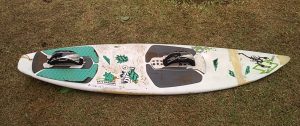For many kiters, riding a kite surfboard is the pinnacle of kiting excitement. Whether hitting the waves, or freestyling on your directional board, there’s nothing quite like it.
Your best choice of board will depend on you as a rider, the conditions you plan to ride in, and the type of riding you want to do. You need to match these three factors with the characteristics of the board: style, size, shape, and fin setup.
We’ve identified our top 5 choices for kite surfboards, with specifications and recommendations for each. Scroll down to see more details about the board characteristics you’ll want to look out for.
| Kitesurf board | Shape | Sizes | Volume | Nose | Tail | Best for |
|---|---|---|---|---|---|---|
| DuotoneWhip | straight outline, parallel rails | 4’9″ to 5.5″ | 16.9L to 26.5L | squared | flat | small wave, freestyle |
| f-one Mitu Pro-flex | shortboard | 5’2″ to 5’10″ | 20.2L to 25.4l | pointed | fishtail | all-around |
| Slingshot Mixer XR | shortboard | 5’8″- 5’10 | 27L – 31L | pointed | winged rounded pintail | Small wave Light wind Beginners |
| DuotoneVoke | squared with parallel rails | 5’1”- 5’3” | 22.5L – 25.3L | flat | flat | dedicated freestyle |
| North Charge | performance Surfboard | 5’5” to 5’11” | 23L to 29.5L | pointed | squash tail | dedicated surf, big wave, beginners |
Table of Contents
#1 Duotone Whip
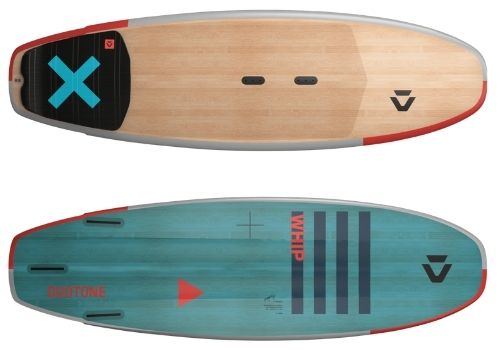
The Duotone Whip is for advanced riders, both freestylers and small to medium wave riders. It’s designed specifically to be ridden powered-up, for fast acceleration and sharp turns.
The Whip is reinforced with Innegra for light-weight strength against cracks and dents, and has a cork shock absorber on the deck. It’s made with enough flex for good pop in the jumps, and equipped with grab rails.
It comes in sizes from 4’9” (16.9 litres) to 5’5” (26.5 liters), for riders ranging from 40kg to over 85kg.
| Duotone Whip size | Volume |
|---|---|
| 4’9″x17 1/4″ | 16.9L |
| 4’11” x 17 3/4″ | 18.7L |
| 5’1″ 18 1/4″ | 21.1L |
| 5’3″ x 18 3/4″ | 23.7L |
| 5’5″ x 19 1/4″ | 26.5L |
#2 F-one Mitu Pro-flex
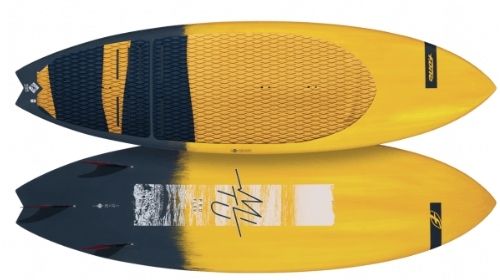
F-one’s Mitu Pro-flex is a true all-rounder – it’s made for all riders, in any condition, for both freestyle/freeride and all kinds of waves.
The Pro-flex has a double-concave hull in the front, transitioning into a single concave toward the rear of the board, allowing it to cut through chop smoothly and with less effort. The sharp rails in the rear makes it turn sharply.
The forward wide point makes it forgiving and stable, and easy for beginners to learn jibing.
It also comes in carbon and bamboo construction. All Pro-flex versions have a 3-fin thruster setup with resin composite fins.
| Mitu Pro-Flex size | Volume |
|---|---|
| 5’2″ x 17.7″ | 20.2L |
| 5’4″ x 18.1″ | 21.8L |
| 5’6″ x 18’1” | 22.8L |
| 5’8″ x 18.5″ | 23.9L |
| 5’10″ x 19.1″ | 25.4L |
#3 Slingshot Mixer XR
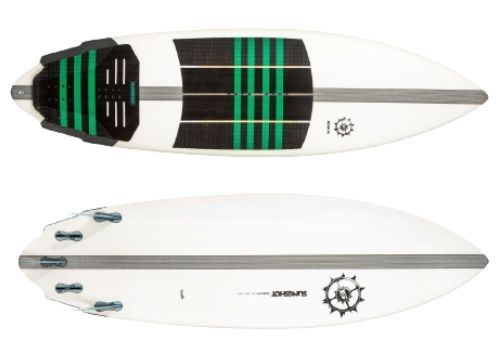
The Mixer, with its larger size and higher volume, is ideal for lighter wind, smaller waves and chop, heavier riders, and beginners.
The EPS core is strengthened with carbon stringers, glass and bamboo layers, and has carbon rail protectors. A quad concave bottom and squashed pintail helps the board keep both speed and control through mushier waves and slower, weaker wave sections.
Fin set-up is left to the rider, with options to ride with either a quad fin setup, a thruster, or even a 5-fin setup.
| Slingshot Mixer size | Volume |
|---|---|
| 5’8″ x 19’3” | 27L |
| 5’10″ x19’5” | 31L |
#4 Duotone Voke
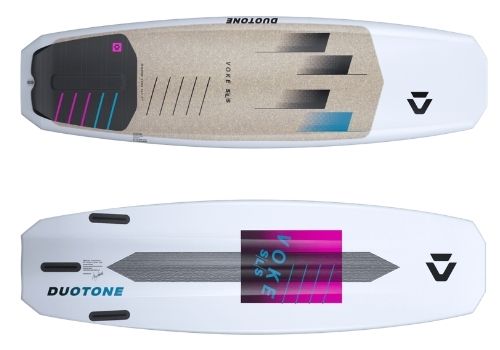
Dedicated to strapless freestyling, the Voke is designed to be ridden using the kite’s power, rather than primarily relying on the energy of waves.
It’s a fast and stable board, with a flat rocker and parallel rail outline. Like the Duotone Whip, it is reinforced with Innegra and has a cork layer on the deck to absorb the impact from hard landings and protect from heel pressure.
The 5’1” size is for riders up to about 85kg, and the larger 5’3” is for riders over 85kg.
| Duotone Voke size | Volume |
|---|---|
| 5’1” x 17 1/2” | 22.5L |
| 5’3” x 18 2 5/16” | 25.3L |
#5 North Charge
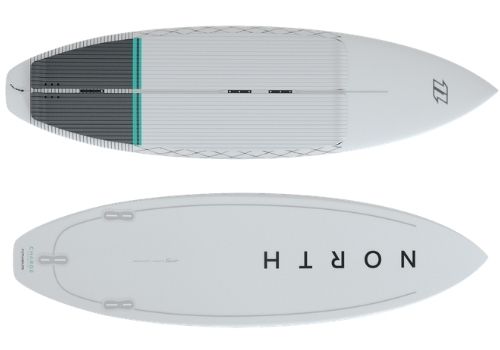
The North Charge is for experienced riders in high winds and large waves. The forward portion of the board has a deep single concave shape, with a slight double concave in the rear.
It’s an epoxy construction with carbon and Innegra reinforcement, and has a slight rocker for easy entry, speed and acceleration.
The carbon tail reinforcement stiffens the rear part of the board for responsive turns. The comfortable traction pad has a foot ridge at the front and large kicktail on the back, and the rails have extra protection to protect from spreader bar dings.
| North Charge size | Volume |
|---|---|
| 5’5” x 18 1/8” | 23L |
| 5’7” x 18 3/8” | 24.7L |
| 5’9” x 18 7/8” | 27.1L |
| 5’11” x 19 3/8” | 29.5L |
What to look for in a kitesurfing wave board (buying guide)
Keep in mind that many board characteristics are trade-offs. A board that’s more stable will be less maneuverable. A board designed for large, steep waves will not be as good in smaller mush and chop. A board that’s good upwind won’t have the skatey, turny feel that some riders like.
Rider and riding style
For the beginner surfer, a larger and wider board with more volume makes everything easier. Later, as you’ve gotten more proficient with your jibes and carves, you can move to a smaller board.
Heavier and taller people also need larger boards. That’s why many boards come in several sizes, with rider weight specs listed by the manufacturers.
If you’re an experienced surfer who loves to spend time in big waves, you may prefer a more surf- specific board.
If you’re a twintip rider and want to expand your abilities doing tricks and jumps on a directional board, a freestyle kite surfboard may be your best option.
Wind and water conditions
Light wind? Get a bigger board. Large, powerful waves? Choose a wave-focused board. Small, mushy waves? You need a board that accelerates well, catches the wave efficiently, and can cut through the chop.
Wind direction also has a big effect on what you’ll want in a board. Onshore wind usually produces waves of lower quality, with less speed and power. Broken waves and chop are common, and rides are shorter.
You need to be able to both turn sharply downwind to avoid closeouts, and cut upwind back out through the waves after each run.
In onshore waves, you’re more often relying on the pull of the kite rather than parking it and riding the wave. You need a board that is agile, turns well, accelerates quickly for early planning, and has good upwind ability. (see board features below)
The best kite wave riding, however, is done in side to side-offshore wind, where surfing down the line and leveraging the power of the waves is a lot easier.
In side shore winds, it’s easier to pick up speed to catch the wave, and you don’t have to worry as much about going upwind. So you will want a board designed for good carves, going rail to rail, and driving through the turns (see board features below).
In offshore conditions, although the waves may be better, you can often expect gustier wind. A board that can ride through the lulls is helpful. You’ll need a board that turns sharply to come off the face of the wave. And, since you’re riding the wave upwind, a board that rides upwind well.
Kite surfboard construction & weight
Regular surfboards (for paddle surfing) are not designed for the higher forces that come with wave kiting and freestyling. The deck may develop dents from the pressure of your heels on the board, and hard landings can crack the board.
Kite surfboards have stronger construction and reinforced decks. They’re generally reinforced with more layers or more stringers. This typically makes kite surfboards a bit heavier, but also costlier.
A grip pad covering the entire deck is convenient; some boards even have an extra cushion underfoot. If you prefer to use footstraps, make sure the kite surfboard has inserts.
Kite surfboard size and volume
Larger boards are more forgiving and require less power input from the kite or from the wave. Use a higher-volume board like the Mixer or the Charge if you’re heavier, you’re new to kite surfboards, or if you mainly go out in light wind or smaller waves.
Shorter boards are more nimble, but more difficult to ride. They move faster, accelerate quicker, turn more sharply, and are more responsive to rider input.
Kite surfboard shape
Wave-specific boards are longer and narrower than freestyle boards, with more rocker and a sharper nose.
They’re designed for the precise steering needed to drop into steep waves and barrels, and to bite into turns without slipping.
Wider, flatter boards are more stable, and can harness wave power more efficiently. They accelerate better, and are more suited to flatter and less-powered conditions.
Rocker (the bottom curve of the board) helps with turning. Lots of rocker makes a board more maneuverable, but also more “twitchy” and difficult to control. Boards with more rocker are better when there is lots of power available from the wave or the kite.
A parallel rail outline tends to make a board faster, with more stability in smaller, flatter waves. When edging, a longer portion of the rail can be submerged for better upwind abilities.
A rounder outline helps a board turn more easily than one with parallel rails. It can also give wider profile in the middle or forward section for easier takeoff.
Kitesurf board nose & tail
The tail refers to the entire rear portion of the board, from the widest point back. A sharper tail gives better control, sharper turns, and is good for strong wind and big waves.
A wider tail gives better acceleration, requires less power, and upwinds better.
Some boards come to a double point tail – a double pintail, or fishtail, or swallowtail. This makes for better turning, while keeping the advantages of a wider tail.
A sharper nose with some upturn, can prevent nosediving in larger waves. Boards intended for smaller, flatter waves and freestyle have flattened or rounded-off noses; this allows the board to be shorter while still keeping a parallel rail outline.
Kitesurf board concave and rails
A concave bottom can push through mush and choppy water better, and provides improved tracking and upwind ability.
A flatter board will tend to feel more “skatey” and have better acceleration. Concave boards also have less flex than flat boards.
Sharper, harder rails cut into the water to give better control at higher speeds. Since kite surfboards are usually ridden much faster and with more power than traditional surfboards, the softer rails of a “normal” surfboard have little benefit.
Kitesurf board fins
Most kite surfboards have a classic thruster (three-fin) setup. Thrusters give direct and predictable control, especially in the turns. They’re best for digging the back of the board into the water to get a deep, sharp turn.
Quad fin setups are less common. They’re faster than thrusters, but have less control and feedback when carving or going rail to rail. In trimming turns, where the rider’s weight is more forward on the board, they give better feel and response.


